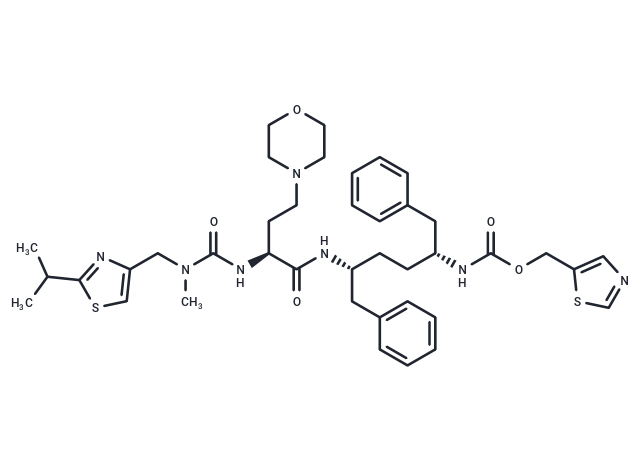Shopping Cart
- Remove All
 Your shopping cart is currently empty
Your shopping cart is currently empty

Cobicistat (GS-9350) is a carbamate and thiazole derivative that functions as a CYTOCHROME P450 CYP3A INHIBITOR to enhance the concentration of ANTI-HIV AGENTS, with which it is used in combination, for the treatment of HIV INFECTIONS.

| Pack Size | Price | Availability | Quantity |
|---|---|---|---|
| 1 mg | $38 | In Stock | |
| 2 mg | $54 | In Stock | |
| 5 mg | $85 | In Stock | |
| 10 mg | $126 | In Stock | |
| 25 mg | $223 | In Stock | |
| 50 mg | $369 | In Stock | |
| 100 mg | $531 | In Stock | |
| 1 mL x 10 mM (in DMSO) | $113 | In Stock |
| Description | Cobicistat (GS-9350) is a carbamate and thiazole derivative that functions as a CYTOCHROME P450 CYP3A INHIBITOR to enhance the concentration of ANTI-HIV AGENTS, with which it is used in combination, for the treatment of HIV INFECTIONS. |
| Targets&IC50 | CYP3A:30 nM-285 nM |
| In vitro | Cobicistat (GS-9350) is a potent, and selective inhibitor of human cytochrome P450 3A (CYP3A) enzymes as a pharmacoenhancer. GS-9350 inhibits CYP3A with IC50 spectrum from 30 nM to 285 nM. In contrast to ritonavir, GS-9350 is devoid of anti-HIV activity, with IC50 of > 30 μM against HIV-1 protease and EC50 of > 30 μM in MT-2 HIV infection assay, and is thus more suitable for use in boosting anti-HIV drugs without risking selection of potential drug-resistant HIV variants. GS-9350 shows reduced liability for drug interactions and may have potential improvements in tolerability over ritonavir. [1] |
| Kinase Assay | Cytochrome P450 Inhibition: Inhibition of human cytochrome P450 activities is determined in duplicate in pooled human hepatic microsomal fractions following current scientific and regulatory guidelines. Reaction conditions are linear with respect to incubation time and hepatic microsomal protein concentration. Substrates are present at concentrations equal to or less than their respective Km values determined under the same reaction conditions. Metabolite and/or substrate concentrations are determined using specific, internal standard controlled HPLC MS/MS assays. For reactions monitoring metabolite formation there is less than 20% consumption of substrate during the reaction. Unless otherwise noted microsomal fraction, diluted in potassium phosphate buffer, is preincubated with substrate and inhibitor for 5 min at 37 ℃ and the reaction initiated by the addition of an NADPH generating system followed by further incubation at 37 ℃ with shaking. Enzyme-selective positive control inhibitors are tested in parallel. At appropriate times aliquots of the mixture are removed and the reaction terminated by addition to a mixture of methanol and acetonitrile containing the respective internal standard. After centrifugation aliquots of the supernatant are subjected to HPLC-MS/MS analysis. |
| Cell Research | Five-fold serial dilutions of the tested compounds are prepared in triplicate in 96-well plates. MT-2 cells are added to plates at a density of 20,000/well in a final assay volume of 200 μL. After a 5-day incubation at 37°C, the cytotoxic effect is determined using a cell viability assay. One hundred μL media is removed from each well and replaced with 100 μL of phosphate-buffered saline containing 1.7 mg/mL XTT and 5 μg/mL PMS. Following 1-hour incubation at 37°C, 20 μL of 2% Triton X- 100 is added to each well and absorbance is read at 450 nm with a background subtraction at 650 nm. The data are plotted as cell viability vs. drug concentration. Cell viability is expressed as a percentage of the signal from untreated samples (0% cytotoxicity) after the subtraction of signal from samples treated with 10 μM of Podophyllotoxin (100% cytotoxicity). The CC50 value is calculated from the inhibition plots as the concentration of drug which inhibits cell proliferation by 50%. |
| Alias | Tybost, GS-9350 |
| Molecular Weight | 776.02 |
| Formula | C40H53N7O5S2 |
| Cas No. | 1004316-88-4 |
| Smiles | CC(C)c1nc(CN(C)C(=O)N[C@@H](CCN2CCOCC2)C(=O)N[C@H](CC[C@H](Cc2ccccc2)NC(=O)OCc2cncs2)Cc2ccccc2)cs1 |
| Relative Density. | 1.228 g/cm3 at 20℃ |
| Storage | Powder: -20°C for 3 years | In solvent: -80°C for 1 year | Shipping with blue ice. | |||||||||||||||||||||||||||||||||||
| Solubility Information | DMSO: 93 mg/mL (119.84 mM), Sonication is recommended. H2O: < 1 mg/mL (insoluble or slightly soluble) Ethanol: 93 mg/mL (119.84 mM), Sonication is recommended. | |||||||||||||||||||||||||||||||||||
Solution Preparation Table | ||||||||||||||||||||||||||||||||||||
DMSO/Ethanol
| ||||||||||||||||||||||||||||||||||||

Copyright © 2015-2025 TargetMol Chemicals Inc. All Rights Reserved.